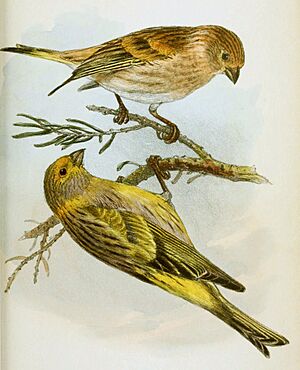Syrian serin facts for kids
Quick facts for kids Syrian serin |
|
|---|---|
 |
|
| Illustration from "The Ibis", a Journal of Ornithology, vol. iv. 1868. | |
| Conservation status | |
| Scientific classification | |
| Genus: |
Serinus
|
| Species: |
syriacus
|
The Syrian serin (Serinus syriacus) is a small, brightly colored bird. It belongs to the finch family, called Fringillidae. This bird is a passerine, which means it's a type of perching bird.
Contents
All About the Syrian Serin
The Syrian serin is a very pretty bird. It has bright yellow and soft pale grey feathers. Its eyes are quite big and have a bright yellow ring around them. The bird's beak is grey, and its legs are a light pinkish-grey color. You might hear it make a long, trilling sound. It can also chirp and twitter.
Where Syrian Serins Live
Syrian serins make their homes in countries like Syria, Lebanon, Israel, and Jordan. They live in high places, usually between 900 and 1,900 meters above sea level. Some of these birds, especially those in Jordan, move around locally in winter. However, birds from Lebanon, Israel, and Syria travel to warmer places for winter. They fly to Egypt, Turkey, and Iraq.
Their Favorite Places to Be
These birds like rocky areas. They often live near oak and conifer trees or bushes. You can also find them in grasslands and open fields. They mostly eat seeds from different plants and grasses. In southwestern Jordan, during winter, they especially love to eat seeds from a plant called Artemisia.
Syrian Serin Life Cycle
When it's time to find a mate, male Syrian serins sing special songs to attract females. Once a pair forms, they build a nest in a tree. They usually start building when the snow begins to melt, around April or May.
Eggs and Chicks
The female bird lays about four glossy, pale blue eggs. This happens in April and May. She sits on the eggs to keep them warm for about 12 to 14 days. This is called incubation. After the chicks hatch, they grow very quickly. They are ready to leave the nest in just 14 to 16 days!
More Broods
After their first set of chicks leave the nest, the parents often move to even higher places. They go up to about 1,750 meters in July and August. There, they can try to have a second group of chicks. If conditions are really good, a pair might even have three groups of chicks in one year! However, in some places like southwest Jordan, most pairs only have one group of chicks. This is because there aren't suitable places for them to breed at higher elevations.
Protecting the Syrian Serin
The Syrian serin is considered a Vulnerable species. This means their numbers are going down, and they need our help. The main reasons their population is shrinking are:
- Logging: Trees where they live are being cut down.
- Farming: Large-scale farming and raising many animals (livestock production) can change their habitat.
- Hunting: Some birds are hunted.
It's important to protect these beautiful birds and their homes so they can thrive.


